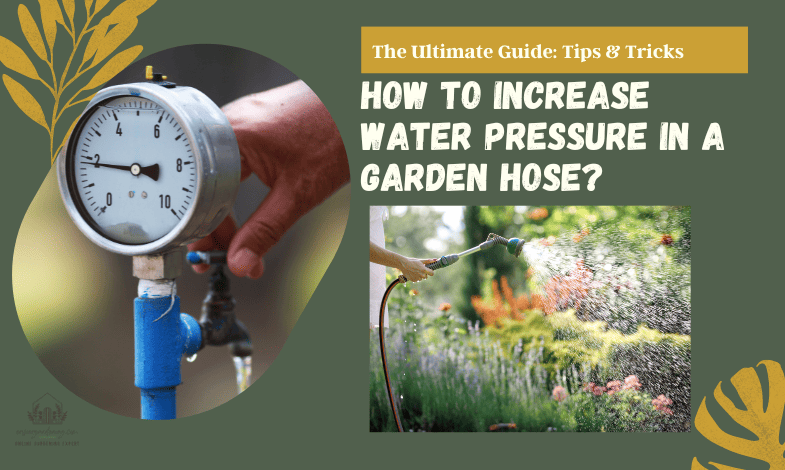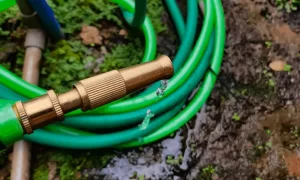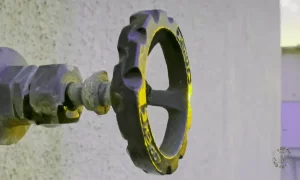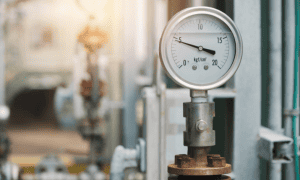How to Increase Water Pressure in a Garden Hose: Life Saving Tips!: Washing the yard and watering the plants in the garden should be a simple daily task. However, depending on the water pressure coming out of the faucet, watering your garden can be a tedious and time-consuming task, especially if you do not have an irrigation system or automatic sprinkler system. Without convenient methods, you will need a hose to reach every spot in the yard. So, are you here to discover how to increase water pressure in the garden hoses? This article will outline some easy ways that you can increase water pressure and some more in-depth solutions to get your water pressure up to maximum efficiency.
Contents
- How to Increase Hose Pressure?
- Easy Fixes to Increase Water Pressure
- Is the water main open?
- Check your hose
- Consider a larger garden hose.
- More Fixes to Increase Water Pressure
- Check for clogged pipes.
- Use a water pressure gauge and regulator.
- How to use the pressure regulator?
- Invest in a water pressure booster
- Tips and Additional Information
- Final Thoughts: How to Increase Water Pressure in a Garden Hose?
- How to increase the water pressure of a garden hose?
- Does a shorter garden hose increase the pressure?
- How to fix low water pressure?
How to Increase Hose Pressure?
Use a garden hose pressure nozzle. You can attach an adjustable nozzle to the outlet end that enables you to increase the water pressure. In the hose, the ideal is to use an electric pressurizer or high-pressure washers. These can be set to low pressure but still pressure the water.
Easy Fixes to Increase Water Pressure
When you discover that your garden hose does not have adequate pressure for your needs, you may want to start thinking that this problem is hopeless. Without strong water pressure, it can be difficult to water plants that are far from the hose. You may also find that it takes longer than usual. The good news is that you don’t have to worry. Many of the solutions to low water pressure are easy and inexpensive to repair. So, if your garden hose has been gradually losing water pressure, it is more likely that one of these easy fixes can help.
Is the water main open?
In addition to fully opening the garden faucet, you also need to check that the main water cock is fully open. You can locate the main tap near the water clock. Sometimes the easiest solutions are those that are often neglected.
Tips: Check that your faucet is fully turned on and that the connection is working properly.
If your garden hose is not securely attached to the faucet, this may be causing water to dilute. Then the water will spray out around the faucet, leading to low pressure. Once you are sure that your faucet is completely on and that the connection is correct, we need to investigate a little further.
Check your hose
Check your garden hose and see if this is your problem. When garden hoses are not stored correctly, they can be damaged by garden tools or the heat of the sun. In addition, they can also dent and impede the passage of water. This damage can create a stiff hose that will likely have permanent kinks or knots in the hose. If water cannot flow freely, it will decrease the water pressure. Another common problem found in garden hoses is holes.
Note: If you have any holes or leaks in your garden hose, this will cause a reduction in water pressure. Solving this problem is simple as you can stick tape to patch leaks in the garden hose. If you have large holes or many holes, you may want to invest in a new hose.
Consider a larger garden hose.
When you are here to find how to increase water pressure in a garden hose, a larger garden hose to increase water pressure can be your solution. If you have thoroughly inspected your hose and found no apparent problems, the solution may lie in the size of your garden hose. Increasing the diameter of your garden hose can help increase water pressure. Just a quarter-inch (6 millimeters) can increase and almost triple the water output. Investing in a larger hose is a simple and inexpensive way to increase the water pressure in your hose.
More Fixes to Increase Water Pressure
If you have tried the list of quick and easy fixes and you still haven’t seen an increase in hose water pressure, there are some deeper fixes you can try. Some of these fixes may come at a higher price, but they are still quick ways to remedy low water pressure.
Check for clogged pipes.
One of the most common causes of poor water pressure is clogged pipes. If you have never cleaned or replaced your old pipes, there is a good chance that this is the cause of your poor water pressure.
Note: If your pipes accumulate particles of oxidation from electrolysis or hard water in the plumbing and other loose pipe materials, these messes can build up and clog your pipes.
A good sign that your pipes are clogged is if there is a sudden decrease in pressure. If you don’t see an increase in water pressure after cleaning your pipes, you may want to replace them. While this is an expensive fix, it will also increase the water pressure in your home and garden.
Use a water pressure gauge and regulator.
If you have checked your garden hose and cleaned your pipes, and still don’t have good water pressure, you may want to check your water pressure at the source.
Before you invest in a piece of equipment, you can do an investigation around the neighborhood; if everyone suffers from low water pressure at home, the most likely cause is that this is a problem with your area’s sewer and sanitation company.
If this is not the case, you can use a water pressure gauge and regulator to see what kind of water pressure you are getting from your property. First, turn off all the water and water-using appliances in your home. Then, connect a water pressure gauge to the front faucet, or where the water first enters the house.
Turn the faucet on fully and check the water pressure. After you have adjusted the regulator, run the faucet for a few minutes before testing the water pressure again.
How to use the pressure regulator?
You need to determine what the appropriate water pressure is for your property. In general, it is known that high places tend to have lower water pressure and low places higher. The ideal water pressure would be around.
Invest in a water pressure booster
If you cannot get good water pressure, you may want to invest in a water pressure booster. A water pressure pressurizer is designed to dramatically increase the flow of water. It is the most efficient way to quickly increase water pressure. However, it can be unaffordable for many people.
If the water pressure throughout your home needs an increase, this may require a larger booster of equipment, which could be even more expensive. However, if you are only looking to increase the water pressure in your garden hose, there are some less expensive alternatives. You could buy a pressure nozzle for your garden hose. This is much more economical and just regarded as useful for increasing the water pressure in your garden hose.
Tips and Additional Information
- Choose a hose that is composed of vinyl or rubber;
- The length of the hose should match the area of your garden;
- Bends add less strength to hoses;
- Select a hose with a wider diameter to increase the water flow per minute;
- When you are finished using the hose, remove the water from inside, roll it up in a circle, and keep it out of the sun.
Final Thoughts: How to Increase Water Pressure in a Garden Hose?
Increasing the water pressure from your garden hose will save you time and energy when watering your lawn or garden area. That’s why you have read this article on how to increase water pressure in garden hoses. The additional pressure will cause the spray to go further and more water to come out of the end of the hose, promoting quicker and more efficient watering. If your garden hose has a small leak and the water pressure drops, it is probably time to buy a new hose.
Frequently Answered Questions
How to increase the water pressure of a garden hose?
The easiest way to increase water pressure in your garden hose is to turn the bolt on the pressure-reducing valve clockwise using a wrench to increase the pressure.
Does a shorter garden hose increase the pressure?
Many gardeners think that using a smaller diameter hose will increase water pressure. This might seem logical, but it is not true.
How to fix low water pressure?
There might be several reasons behind the low water pressure in your garden hose. You can solve this by clearing the Clogs, replacing the regulator, fixing any leak, or installing a water pressure booster pump.




